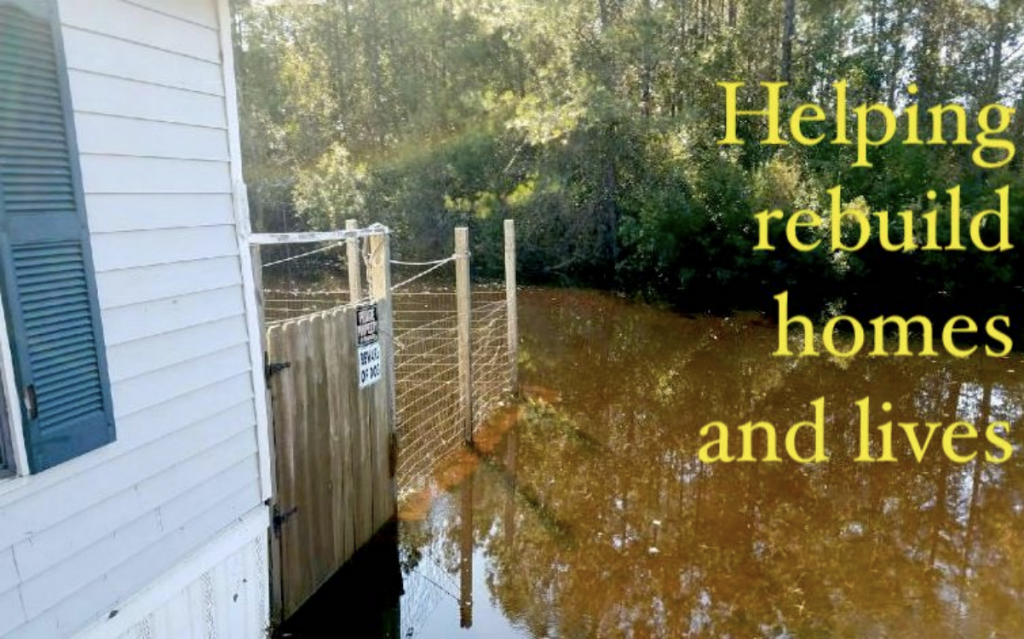Helping Rebuild Homes and Lives

“It came as fast as you could get anything and get out.” Chris Edwards, homeowner
The River
The lazy Black River meanders 50 miles through three counties and several small rural towns in Eastern North Carolina. The river is so named for its stained color, like dark tea, which comes from the tannins of decaying vegetation in the river. It’s a favorite destination for fishermen and kayakers.
In the 1980s, the river became widely notable after two professors from the University of Arkansas discovered the oldest tree east of the Rockies among those in the surrounding ancient bald cypress forest. Methuselah, as it came to be called, dates to at least 364 A.D.
In 1994 the Black River was designated an “outstanding resource water”, the highest water quality rating given in the state.
The Hurricane
On October 7-8, 2016, the scenic river became unrecognizable after Category 1 Hurricane Matthew stormed through the area leaving record rain and flooding in its wake— and 92 homes 2 uninhabitable. Roads were closed, power was out and rivers in the area continued to crest for more than a week. It didn’t help that the ground was already saturated from a month of steady rain, some from Hurricane Hermine.
Despite Matthew’s eye staying off the North Carolina coast, the hurricane was directly responsible for 32 deaths in the state, most due to flooding. Economic losses totaled $5.0 billion with only $1.0+ billion insured.
Matthew was the most powerful storm of the 2016 Atlantic Hurricane Season. The name has been officially retired from the list of Atlantic hurricane names.
After the storm
The Federal Emergency Management Agency (FEMA) bought out some of the homes. Twenty-six were marked for rebuild. Nineteen were supposed to be elevated. The rest were either torn down, abandoned or put up for sale. Residents couldn’t even seek refuge and solace at historic Bethlehem Baptist Church in Currie, a cornerstone of the community since 1800. It had sustained significant damage. And it had no flood insurance.
Some of the residents had flood insurance; most did not. One flooded family had cancelled their flood insurance two weeks before the hurricane so they could pay for their medical insurance.
Elusive funding
The devastation in the Black River community quickly disappeared from the public eye in spite of the efforts of The Cape Fear Network of Churches (formerly the Wilmington Baptist Association) that recruited hundreds of volunteers to rebuild this community. Money was needed for materials but other areas of the state were deemed more severely impacted and worthy of assistance. Even several official online sites with final statistics about the hurricane’s effects in North Carolina barely give the Black River area a mention or give it none at all.
Limited funds and federal bureaucracy threatened the rebuild progress for several homes, including that of Chris and Janet Edwards in Atkinson. Their home was a tear out and had to be rebuilt. The Edwards had lost everything and were renting another home.
FEMA was unable to assist the Edwards with restoration because the family was unwilling to raise their double-wide mobile home the eight to ten feet necessary to prevent another flooding. Mrs. Edwards has critical medical needs, including almost daily dialysis that prevent her from entering an elevated home unless a ramping system is installed to make it wheelchair accessible. But since her husband works and her children are in school during the day, the family would have to hire a caregiver to assist her on the ramp. They decided to leave the home’s access on a lower level and restore it on its original footprint with the help of the Faith Harbor United Methodist Church (Surf City) Restoration Team and other volunteers.
Bennett Hunter of Faith Harbor UMC reached out to the local Kiwanis Club in mid-2017 for donations to make up a shortfall in a pledge the church had made for the Edwards’ rebuild. Hearing this, EAMC affiliate David Stipe approached the EAMC Board of Governors, which was looking for appropriate local mission projects. The chapel approved the $1800 that was needed.
EAMC helps
Then the hurricanes of fall 2017 struck and all eyes were on Texas and Florida. The scale of devastation was staggering so federal aid was being diverted to those states.
EAMC’s Board of Governors reflected on how best to address these needs and bear witness to Jesus while being good stewards of monies that had been entrusted to the chapel by its donors. About this same time, EAMC affiliates Freddie King and Dave Stipe visited the Edwards’ home to see firsthand the family’s plight. After they shared their findings with the board, the question of how to help after the recent hurricanes was quickly answered with a decision to support relief efforts in the chapel’s own backyard. It had been over a year since Matthew had struck the Black River area and several families, in addition to the Edwards, still were not back in their homes. The board unanimously approved $20,000 to help rebuild this impoverished community.
So far at the Edwards’ home, $10,700 of the chapel’s funding has been spent on building and plumbing supplies, HVAC installation and doors. Both EAMC’s Rick Benton and Faith Harbor’s Bennett Hunter have worked on the project. Expenditures have been approved only for specific materials in order to ensure that the chapel’s donation is spent responsibly. If the remaining $9300 is not required for the Edwards’ home, it will be used to support other identified restoration needs until the full amount has been spent helping the residents of this devastated community rebuild their homes and their lives.
Now
Bethlehem Baptist Church reopened its doors with a rededication ceremony in mid-January, much to the delight of the locals as well as the cadre of volunteers who made it happen.
In spite of recent wintry weather slowing down the work of the volunteers, four more families are expected to move into their “new” homes in April, including Chris and Janet Edwards who will move in on April 7, almost eighteen months to the day after they had to move out.
For more information and photos, visit:
Neighbors work to help those displaced by Matthew finally return home, Port City Daily, 5/25/17.
In Rural Pender County, slow recovery from Hurricane Matthew, Star News Online, 10/5/17, updated 11/2/17.
Helping Pender County family bounce back from hurricane, WECT, 2/7/18.
A Facebook page dedicated to the Black River rebuilding project has several entries between November 2017 and February 2018 with photos of the Edwards’ home.
____
By Laura Dillman, Newsletter Editor Emma Anderson Memorial Chapel April 1, 2018
